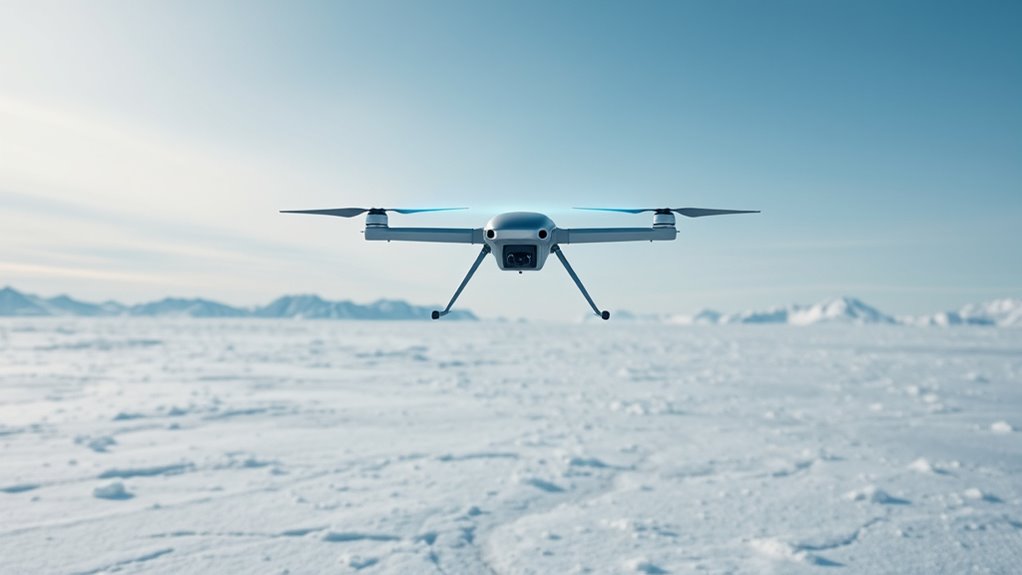AI is revolutionizing science by allowing you to explore the frozen frontiers of knowledge more deeply than ever. It speeds up data analysis in biology, climate, physics, and more, uncovering hidden patterns and driving discoveries at unprecedented speeds. AI automates complex experiments, enhances predictions, and reduces research time, helping you push past previous limits. By harnessing AI’s power, you’ll discover new insights and reveal mysteries that have long remained out of reach. Keep exploring to learn more.
Key Takeaways
- AI accelerates climate modeling, enabling deeper understanding of polar changes and environmental impacts in frozen regions.
- In astrophysics, AI processes massive space data, revealing hidden cosmic patterns and expanding knowledge beyond previous limits.
- AI enhances the exploration of icy planets and moons by analyzing remote sensing data and predicting surface processes.
- In cryobiology and cold-region medicine, AI improves diagnostics and research involving extreme cold environments.
- AI-driven simulations and robotics enable deeper, more precise research into glacial formations, permafrost, and polar ecosystems.

Artificial intelligence is transforming science by accelerating research, enhancing accuracy, and enabling new discoveries across various fields. You’re now able to analyze complex biological and genetic data faster than ever, which speeds up drug discovery and paves the way for personalized medicine tailored to individual genetic profiles. Deep learning models sharpen diagnostic precision, especially for challenging conditions like cancer and neurological disorders, by improving the accuracy of image analysis. This means that diseases are identified earlier and more reliably, saving lives and reducing treatment costs. In drug development, AI predicts molecular interactions with remarkable speed, slashing the time needed to identify new treatments from years to mere months. Robotic systems powered by AI automate lab experiments, increasing both the precision and throughput of biological research, so you get results faster and with fewer errors. AI-driven protein engineering helps anticipate viral mutations and design broad-spectrum inhibitors, preparing us better for emerging pathogens and future pandemics. AI’s rapid progress continues to provide researchers with unprecedented tools to explore biological complexities at an accelerated pace. Furthermore, seeking professional counseling can be essential for both scientists and their teams to navigate the emotional challenges that arise in high-stakes research environments.
In climate science, AI accelerates modeling by processing vast datasets efficiently, reducing simulation times from months to days or even hours. You can now generate more accurate climate forecasts and better assess potential impacts of social and environmental hazards using integrated global systems models powered by machine learning. AI also makes climate models more accessible to non-experts by simplifying complex data and predictions, promoting wider understanding and informed decision-making. Environmental scientists leverage AI to analyze enormous amounts of sensor and telescope data, boosting productivity and uncovering patterns that might otherwise stay hidden. Collaborative AI tools integrate diverse data sources, helping policymakers and researchers develop more effective sustainability strategies by providing comprehensive risk assessments.
In physics and astrophysics, AI played a key role in discovering the Higgs boson by interpreting collider data in real-time, demonstrating how machine learning manages massive data streams to optimize experiments. It reduces noise and enhances relevant signals, making breakthroughs possible faster. AI also supports theoretical physics calculations that are traditionally time-consuming, enabling researchers to explore fundamental laws more efficiently. In astronomy, AI processes colossal observational datasets, increasing research efficiency by over 50%, and recognizes patterns in cosmic phenomena like black holes and dark matter, leading to better predictions and understandings of our universe.
Within genomics and drug development, AI automates DNA sequencing and marker identification, drastically reducing human labor and errors. Widespread adoption—up to 80% in genomics—means research is more cost-effective and faster. AI models predict which compounds are worth testing physically, cutting costs by nearly half and shortening timelines. Routine tasks are automated, freeing researchers to focus on innovative ideas. Enhanced diagnostic tools powered by AI also lower healthcare costs by providing more accurate and early detection of diseases.
In applied sciences, AI improves image classification for quality control, such as detecting defects in photovoltaic modules, supplementing traditional statistical methods. You benefit from increased prediction accuracy and more reliable insights, helping industries optimize processes and ensure higher standards. Overall, AI pushes science into uncharted territories, making discoveries faster, more precise, and more impactful than ever before.
Frequently Asked Questions
How Does AI Improve Data Analysis Speed in Scientific Research?
AI improves data analysis speed in scientific research by automating time-consuming tasks like data cleaning and normalization, allowing you to process large datasets quickly. It identifies patterns, outliers, and trends faster than manual methods, enabling you to make faster, more informed decisions. With AI’s rapid processing capabilities, you can explore complex data, generate insights, and accelerate discoveries, ultimately pushing science further and more efficiently than ever before.
Can AI Predict Future Scientific Discoveries Accurately?
You might think AI can predict future scientific discoveries with perfect accuracy, but it’s more like chasing shadows. AI can forecast likely trends based on patterns, yet it’s not foolproof. It’s important to remember that predictions depend on existing data and human expertise, which means surprises can still happen. So, while AI is a powerful tool, it’s only part of the puzzle in uncovering groundbreaking discoveries.
What Are Ai’s Limitations in Extreme Cold Environments?
In extreme cold environments, you face sensor degradation, equipment failures, and data noise that reduce AI accuracy. Limited access makes maintenance tough, and sparse data hampers training. The models struggle to adapt to rapid changes and unprecedented conditions, while hardware risks thermal stress and power shortages. Connectivity issues and resource constraints further limit real-time processing, making reliable AI performance in these harsh settings a significant challenge.
How Does AI Handle Ambiguous or Incomplete Scientific Data?
You rely on AI to handle ambiguous or incomplete scientific data by using probabilistic models and Bayesian inference, which express uncertainty clearly. You’ll see ensemble and stochastic methods produce varied outputs, reflecting inherent ambiguity. To avoid misleading results, AI explicitly signifies data uncertainty, adapts with innovative techniques like learning from missing data, and emphasizes data quality through validation. This approach ensures your models remain accurate, trustworthy, and ethically sound despite data gaps.
Are There Ethical Concerns With Ai-Driven Scientific Advancements?
Did you know that 78% of AI experts highlight ethical concerns in scientific advancements? You should be aware that AI-driven innovations raise significant ethical issues, like bias, transparency, and privacy. You might unknowingly contribute to discrimination if AI systems use biased data. Ensuring fairness, clear explanation of AI decisions, and safeguarding personal information are crucial. Addressing these concerns helps maintain trust, uphold justice, and prevent harm as AI shapes future scientific progress.
Conclusion
As you push the boundaries of discovery with AI, you realize that while it explores the frozen frontiers of knowledge, it also uncovers the icy depths of uncertainty. Just as the technology uncovers secrets hidden beneath the surface, it reminds you that every breakthrough reveals new mysteries. In this dance between progress and the unknown, you find that the more you explore, the more you understand how much remains to be discovered—and how little you truly know.









